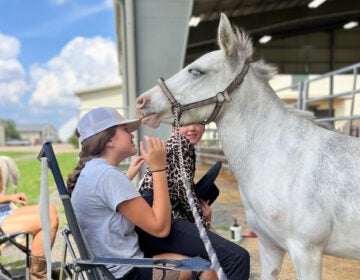TCNJ opens the border with ‘Video Cubano’
Cuban culture is a complex mix of contrasting influences. Its music, a creole of African and European sound, is recognized throughout the world; its cuisine is a fusion of Spanish, African and Caribbean flavor and spices (albeit in short supply); and Cuban literature has its own voice.
Cuban art reflects the nation’s demographic diversity, with contemporary artists emerging after the 1959 Cuban Revolution. In Havana, architecture ranges from Colonial, Baroque and Neo-Classical to Art Nouveau, Art Deco and Modernism.
This nation with a small ecological footprint boasts low rates of illiteracy and infant mortality, high life expectancy, and its healthcare and education system are models. Although taste for and curiosity about Cuba are high, travel to the island is still restricted to journalists, academic professionals, or those engaged in humanitarian, non-profit, government or religious work.
Now through Dec 15
The College of New Jersey is presenting a window into Cuban culture with Video Cubano, an exhibition of 22 videos created by Cuban artists during the past 10 years, through December 15.
A one-minute video by Luis Garciga turns the rhythmic sound of a ping-pong ball bouncing off a hard surface into music. It starts off with an athletic ping-pong player thwacking the ball back and forth with his paddle. In the background we see a white tile wall with a significant number of missing tiles. At first we assume he is playing against another player, but soon we see he’s playing off the cinderblock wall inside an open white cabinet. He keeps up a steady rhythm until the ball rolls out of the little cubby space on the wall, then the player picks it up and starts all over again. This process of start and repeat, and determination, is universal, but the decaying surroundings are typical to Cuba.
Behind the player is a stove that looks vintage 1950s, and a window with bars. The U.S. embargo against Cuba, as well as bureaucratic ineffectiveness, lack of a market economy, and the loss of Soviet subsidies, have led to a crumbling infrastructure. “The irony is, he’s playing against an empty Russian refrigerator,” said curator Rachel Perera Weingeist. “Cubans don’t even have a food supply.”
Another video takes us on a tour of a deserted baseball stadium, as a voice-over narrator describes a great moment in the game when he and “Mario” were carried up on the shoulders of the other players. “I could never strike Mario out,” he says in the beginning. Nobody could beat his team. They even played “The Yanquis.” The narrator threw his best pitches and struck them all out. They were heroes, but those days are gone. The epilogue recounts how Hurricane Ike, in 2008, caused considerable human and economic damage throughout the country.
The national game of Cuba, baseball is quite unifying, said Weingeist. “It’s a small pocket of privilege. One of the only ways to get off the island is traveling with your baseball team, and as with ballet, a large amount defection takes place that way.”
Another video flashes numbers across the screen as a Spanish speaking male recites them. These numbers are excerpts of Fidel Castro’s speeches.
The videos are part of the private collection of Shelley & Donald Rubin, largely known for their Tibetan and Indian art collections, and for New York’s Rubin Museum dedicated to the collection, display and preservation of the art of the Himalayas. Curator Weingeist, senior advisor to the Rubin Foundation, says the Rubins only began collecting Cuban art four years ago. “The Rubins have a large appetite for what is innovative and unique, and Cuba is fascinating to Mr. Rubin, so he started building bridges to see the artwork,” she said.
Weingeist traveled to Cuba to visit artists’ studios. She found the videos an accessible medium for fostering cross-cultural dialogue.
“The videos show a very contemporary slice of life,” she said. “Because of censorship and a totalitarian government, artists have to create a visual language to express themselves and the result is poetic. There’s a lot of allusion and metaphor that only hint at what they’re really thinking and feeling. The government controls museum exhibitions and galleries, and artists don’t have the opportunity to show the work we’re showing.”
Although Cuba is not known as a hotbed of high-tech equipment, video artists may have access to equipment based on their personal finances. Having family in the U.S., the ability to travel or win grants or residencies can enhance their ability to get equipment.
Many of the films in Video Cubano examine aspects of daily life in Cuba, including political propaganda and the military, while other videos explore themes of perseverance and survival.
On Friday, November 8, from 11:30 a.m. to 12:20 p.m., artist Geandy Pavon will lecture on Vanitas: The Political Still Life. Born in Cuba and educated at the Escuela Nacional de Artes Plásticas, Pavón lives in New Jersey. His talk will be presented in Mayo Concert Hall in TCNJ’s Music Building as part of the Center for the Art’s Brown Bag lecture series.
TCNJ Art Gallery is located in the Arts and Interactive Multimedia Building, 2000 Pennington Road, Ewing. Gallery hours Tuesdays, Wednesdays and Thursdays, noon to 7 pm, Sundays 1 to 3 p.m. tcnj.edu/artgallery or 609-771-2633.
_____________________________________________
The Artful Blogger is written by Ilene Dube and offers a look inside the art world of the greater Princeton area. Ilene Dube is an award-winning arts writer and editor, as well as an artist, curator and activist for the arts.
WHYY is your source for fact-based, in-depth journalism and information. As a nonprofit organization, we rely on financial support from readers like you. Please give today.











